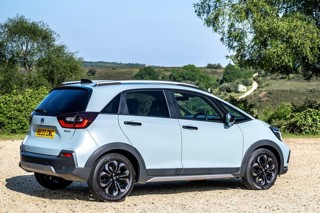Review
Honda's all new CR-V – the only British built car making its world debut at this month's Tokyo Motor Show – is new from-the-ground-up. It features a freshly designed powertrain and major new features and equipment.
The second generation CR-V (pictured below) employs Honda's global Compact Car Platform allowing greater interior length and height within a body of about the same size as before: length and width are slightly increased, height and wheelbase are identical.
Honda has also improved the CR-V's two-way tailgate. It still has a separate upper glass hatch that allows small items to be quickly popped into the back of the car for maximum convenience, but this now forms part of the lower side-hinged tailgate, rather than being separate from it. It means that the glass hatch no longer needs to be opened first in order to open the tailgate.
The new model uses a development of Honda's compact and technically efficient toe control link MacPherson strut front suspension and the reactive link double wishbone rear suspension systems. The result, Honda says, is a chassis offering passenger car like comfort and stability and nimble handling.
The new CR-V is powered by Honda's latest 2.0 litre 150PS DOHC i-VTEC, similar to that found in the Stream and the Civic Type-R. It powers the CR-V 5-speed manual from standstill to 62 mph in under 10 seconds. Fuel consumption on the combined cycle is expected to be well over 30 mpg.
The CR-V is offered with either a floor-mounted five-speed manual shift, or Grade Logic 4-speed automatic with dash-mounted selector lever. Both transmissions are matched to the intelligent 4WD system that automatically engages all-wheel drive only when it is required.
The CR-V offers more interior flexibility. The provision of 60:40 split sliding rear seats together with a load floor that is 120mm lower means that load volume now ranges from 527 to 628 litres, up from 374 litres. When the rear seats are tumbled forwards into their almost vertical storage position – with headrests in place – that figure rises to 952 litres. The waterproof storage container positioned beneath the load floor, plus its lid that doubles as a picnic table continue in the new CR-V. The table is now taller and easier to use while the top has a larger surface area.
Honda believes the new CR-V is capable of achieving a four star rating in the Euro NCAP front and side impact tests, as well as a three star rating in the pedestrian protection tests thanks to a body designed to reduce injuries. Together with front and side airbags, double pre-tensioners on front seatbelts, three rear 3-point seatbelts, Iso Fix child seat mountings (on rear seats) and whiplash-reducing front seats – all standard on both grades – the CR-V should be one of the safest SUVs on the market.
In Britain, the CR-V will be marketed in two trim levels – SE and SE Sport. Both will share the same mechanical specification, and be available with manual or automatic transmission. All models are equipped with air conditioning, four airbags, alarm, CD tuner, electrically adjustable (and heated) door mirrors, driver's seat height adjustment, picnic table, rear accessory power socket – in addition to "standard" Honda features such as power steering, electric windows, remote central locking and rolling code key transponder-type immobiliser.
The SE Sport grade adds alloy wheels, climate control air conditioning, headlamp washers, sunroof, body colour bumpers, mirrors and side protectors, outside temperature display and hard spare wheel cover (in lieu of vinyl).
The CR-V can also be equipped with a wide range of acessories, including DVD satellite navigation, tailgate spoiler, front fog lights, grille guard and tail pipe finisher.
Following its introduction to Europe in 1997, almost 138,000 CR-V's have been sold. Honda expects European sales of the new CR-V to reach in the region of 33,000 in the first full year, rising to 38,000 and 44,000 in subsequent years. In Europe, Britain is the number one market for CR-V, with cumulative sales now exceeding 30,000. Other strong markets are Germany, Italy and France, in that order. In Britain, the new CR-V is expected to sell at the rate of approximately 10,000 per annum.
Like its predecessor, the new CR-V will be built not only in Japan but also at the company's Swindon plant. The UK plant has recently expanded its capacity to 250,000 units per annum, and has become a key element in Honda's Global Supply Network. It will be become a major supplier of the CR-V for the North American market, in addition to meeting the needs of Europe. Sales in Britain commence spring 2002.
##CR-V 2002--none##
Factsheet
No information available.














